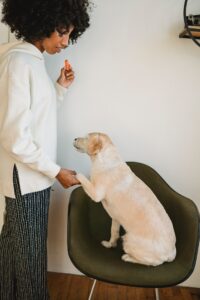Can an old dog be taught new tricks?
Have you ever thought to yourself, “I wish my dog could perform tricks like that,” after seeing a well-trained dog?
Most dog owners undoubtedly wish they could train their dog to perform some of the tricks they watch other dogs perform, but there is one thing they must remember above all else before embarking on the path of teaching tricks. At the very least, the dog must be able to perform basic obedience. If it is a bad-behaving dog to begin with, teaching it to do tricks will be difficult.
Before you begin trick training, make sure your dog understands fundamental instructions like sit, down, and heel. This will make things much simpler later on. Once you’ve mastered them, you can start building on them, and your dog will be wowing your guests in no time with the following three basic feats.
Begging

To begin training your dog this trick, place him in a corner of the room with his back to the wall and you in front of him. The walls will support your dog and offer him the assurance that if he lifts his front legs off the floor, he will not fall over.
Hold some little bits of food above your dog to entice him to reach up and get it. Praise him each time he eats and gently repeat the technique, pushing him to reach higher each time.
You must ensure that the dog’s haunches remain on the ground while urging him to reach for the food. This is accomplished by shifting the dog’s weight back over his haunches and training him to maintain his balance by moving the food back over his head slightly.
Once you’ve perfected the begging trick in the corner of the room, gradually move away from the wall and practice the trick without the dog’s back support. You should anticipate the dog to appear to regress in his learning at this point, but that is to be expected until he can master it using only his own body weight.
Shaking hands

This trick has two elements that your dog must learn. A verbal and non-verbal component that work together to signal to the dog that you want him to execute the trick.
To begin, the dog should be in a sitting position. Give him a single verbal command, such as shake, while extending out with your right hand until it is only inches away from your dog’s right leg. The nonverbal cue is your outstretched hand.
Your dog will most likely sit still at first, unsure of what to do, so gently push or nudge his right leg forward until it rests in your right palm with your left hand. When he’s finished, give him a pat on the back so he understands he’s done what you asked.
Praise yourself after each good outcome and progressively reduce the amount of left-hand prompting until just the verbal and non-verbal signals are required.
Shaking the head: No

You’ll need to locate anything that makes your dog shake his head naturally before you can start teaching him this technique. Blowing softly on the ear, tickling the ear with a feather, or delicately fastening a paperclip to the ear may all be helpful, but remember not to cause the dog any discomfort.
Once you’ve figured out how to get him to shake his head, you’ll need to figure out which verbal and nonverbal cues to employ. One approach is to use a single phrase such as head and shrug your shoulders.
When training your dog this skill, he should begin in a sitting position. Use these cues, as well as the prod (tickling his ear, etc.) to encourage your dog to shake his head, similar to the shaking hands technique. Reward him once he has done so, even if it is only a tiny movement.
This skill is best done in short sessions with rests in between, so don’t try to practice it more than five times in one sitting or the dog may grow confused and not learn.
Reduce the amount of poking gradually until just the verbal and nonverbal signals are required. Once your dog has learned the trick, you may teach him to do it in both standing and lying positions.
The most important thing to remember while teaching dogs to perform tricks is that patience is a virtue and that the dog will learn at his own pace. If the dog does not appear to be learning, do not reprimand him; instead, be patient and encourage him more.




